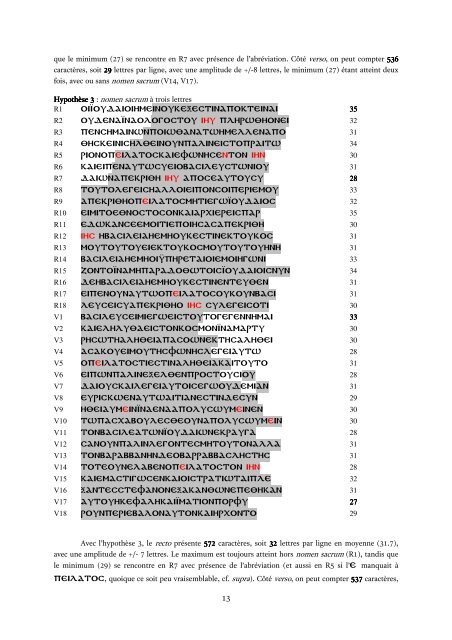Le P52 (P. Rylands.Gr.457) contenait-il un nomen sacrum pour "Jésus" ?
Examen de la présence ou non des nomina sacra dans le plus ancien manuscrit grec du Nouveau Testament.
Examen de la présence ou non des nomina sacra dans le plus ancien manuscrit grec du Nouveau Testament.
You also want an ePaper? Increase the reach of your titles
YUMPU automatically turns print PDFs into web optimized ePapers that Google loves.
que le minimum (27) se rencontre en R7 avec présence de l’abréviation. Côté verso, on peut compter 536<br />
536<br />
caractères, soit 29 lettres par ligne, avec <strong>un</strong>e amplitude de +/-8 lettres, le minimum (27) étant atteint deux<br />
fois, avec ou sans <strong>nomen</strong> <strong>sacrum</strong> (V14, V17).<br />
Hypothèse Hypothèse 3 : <strong>nomen</strong> <strong>sacrum</strong> à trois lettres<br />
R1 oiIoudaioihmeinoukecestinapokteinai 35<br />
R2 oudenaInaologostou ihu plhrwqhonei 32<br />
R3 penshmainwnpoiwqanatwhmellenapo 31<br />
R4 qhskeinishlqeino<strong>un</strong>palineistopraitw 34<br />
R5 rionope<strong>il</strong>atoskaiefwnhsenton ihn 30<br />
R6 kaieipenautwsueiobas<strong>il</strong>eustwniou 31<br />
R7 daiwnapekriqh ihu aposeautousu 28<br />
R8 toutolegeishalloieiponsoiperiemou 33<br />
R9 apekriqhope<strong>il</strong>atosmhtiegwIoudaios 32<br />
R10 eimitoeqnostosonkaiarxiereispar 35<br />
R11 edwkanseemoitiepoihsasapekriqh 30<br />
R12 ihs hbas<strong>il</strong>eiahemhoukestinektoukos 31<br />
R13 moutoutoueiektoukosmoutoutouhnh 31<br />
R14 bas<strong>il</strong>eiahemhoiUphretaioiemoihgwni 33<br />
R15 zontoInamhparadoqwtoisIoudaioisn<strong>un</strong> 34<br />
R16 dehbas<strong>il</strong>eiahemhoukestinenteuqen 31<br />
R17 eipeno<strong>un</strong>autwope<strong>il</strong>atosouko<strong>un</strong>basi 31<br />
R18 leuseisuapekriqho ihs sulegeisoti 30<br />
V1 bas<strong>il</strong>euseimiegweistoutogegennhmai 33<br />
V2 kaielhluqaeistonkosmonInamartu 30<br />
V3 rhswthalhqeiapasownekthsalhqei 30<br />
V4 asakoueimouthsfwnhslegeiautw 28<br />
V5 ope<strong>il</strong>atostiestinalhqeiakaitouto 31<br />
V6 eipwnpalinecelqenprostousiou 28<br />
V7 daiouska<strong>il</strong>egeiautoisegwoudemian 31<br />
V8 euriskwenautwaitianestindes<strong>un</strong> 29<br />
V9 hqeiaumeinInaenaapoluswumeinen 30<br />
V10 twpasxaboulesqeo<strong>un</strong>apoluswumein 30<br />
V11 tonbas<strong>il</strong>eatwnIoudaiwnekrauga 28<br />
V12 sano<strong>un</strong>palinlegontesmhtoutonalla 31<br />
V13 tonbarabbanhndeobarrabbaslhsths 31<br />
V14 toteo<strong>un</strong>elabenope<strong>il</strong>atoston ihn 28<br />
V15 kaiemastigwsenkaioistratiwtaiple 32<br />
V16 cantesstefanonecakanqwnepeqhkan 31<br />
V17 autouhkefalhkaiImationporfu 27 27<br />
27<br />
V18 ro<strong>un</strong>periebalonautonkaihrxonto 29<br />
Avec l’hypothèse 3, le recto présente 57 572 57 caractères, soit 32 lettres par ligne en moyenne (31.7),<br />
avec <strong>un</strong>e amplitude de +/- 7 lettres. <strong>Le</strong> maximum est toujours atteint hors <strong>nomen</strong> <strong>sacrum</strong> (R1), tandis que<br />
le minimum (29) se rencontre en R7 avec présence de l’abréviation (et aussi en R5 si l’e manquait à<br />
pe<strong>il</strong>atos, quoique ce soit peu vraisemblable, cf. supra). Côté verso, on peut compter 53 537 53 caractères,<br />
13



